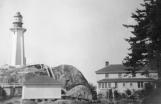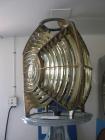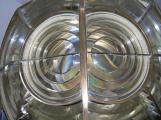7
1st order Fresnel lens used in lighthouse in Chilang, China.1910
Chilang, China
 Credits:
Credits:Courtesy of Elaine Graham.
8
Dioptric lensBy the time the current tower was built in 1912, a Frenchman, Augustin Fresnel, revolutionized the science of the lighthouse lens. Fresnel designed a system that condensed the light into a horizontal beam. He took a central piece of glass-the bull's eye-and constructed a number of concentric rings of class around it. By bending-or refracting-the light rays in a desired direction, the dioptric lens concentrated and focused a very weak light into a bright and powerful beacon.
Dioptric lenses are classified into seven main groups or orders. First order lenses are the largest and most powerful. The dioptric lens at Point Atkinson in 1912 was a third order lens and would show two flashes every five seconds. During the day, a canvas curtain covered the housing for the lens so sunlight did not refract off the prism and create a fire hazard.
9
The pilot's station (foreground) and the Point Atkinson lighthouse and keeper's duplex (background).1940
Point Atkinson, West Vancouver, British Columbia, Canada

10
The year [Grafton] took over, the entire station was transformed. The old dwelling and tower were torn down. Colonel Anderson sized upon the publicly accessible site to show off his latest concrete design-a hexagonal tower embraced by six buttresses-an adroit combination of aesthetics and function which always evokes a chorus of 'oohs' and 'aahs' and 'far outs' from those who climb the Lighthouse Viewpoint and see it for the first time soaring up from below. The steam engines were thrown piece by piece into the chuck and a new fog alarm building was constructed to house internal combustion engines, air compressors, and diaphones.- From Don Graham, Keepers of the Light, 1985, pp. 71-72.
11
Weights from Point Atkinson Lighthouse.2004
Point Atkinson, West Vancouver, British Columbia, Canada

12
The light mechanism weighed approximately 1600 pounds. It floated in a 400 pound mercury tank. A clockwork system turned the lens. A cable with weights ran the height of the tower and was wound up when the weights reached the bottom. Until an electric motor was installed in 1963, the light keeper had to wind up the weights ever 2 ½ hours-the time it took the weights to reach the bottom of the tower.13
Prism from Point Atkinson Lighthouse.2004
Point Atkinson, West Vancouver, British Columbia, Canada

14
The first light source for the third order Fresnel lens worked on the pressure vapour principle and burned vaporized oil. A mantel about two inches in diameter was used. In 1960, an electric light bulb replaced the vaporized oil. During the 1980s, the Canadian Coast Guard used Point Atkinson as a test site for automated lighthouse systems. Today, a much smaller solar-powered light has replaced the electrical one.15
Pg 7 of the Rules and Instructions for Light Keepers told lightkeepers how to take care of the light1904
Canada

16
Maintaining the rotation of the light was an ongoing duty, and one that was made extremely difficult in poor weather conditions.Larry Grafton remembers:
That was a curse having to wind that thing up every 2 ¾ hours or whatever it was, because you know, they have railings in there, but in the old days they just had the one hand rail…You went down 12 steps and they had this little platform and the next railing was way over here and you would get down there in the dark and you were just easing along the cement wall until you hit the rail. Snow used to blow right through the ventilation system, you know, cause they, outside the ventilation was open and then they had a wall in between, I guess its still there, came over the top and out the ventilation…in the beacon room, you got a wild wind in a snow storm, the snow used to go right down the tower and you had to go up there in the dark and wind the clockworks, pretty slippery sometimes.
17
Norm Dawe remembers:You would light up at sunset. Then … start the lens rotating…inside the lens, right in the centre there is a tube which is surrounded by the burner and first you would preheat this tube…you put methylene spirits-alcohol-in it, and heat the tube with that, preheat it and then turn the fuel on, it was a mixture of air and kerosene, and then from there you would light the mantle. It was basically similar to today's Coleman camp stove…. It was larger and was run by kerosene or in later days stove oil was used…the lens itself is very heavy…it's very heavy… and for a bearing so this will turn, what they use is a bath that has mercury in it and the base of the turning part, sits in this bath of mercury floats. Like if you had a mechanical bearing, something with a squirt of oil in it once and a while you know it would take a lot to turn it. With it floating in the mercury, you could turn it with your finger pretty well, something that weighs a ton or so. Now this rotated with the clock work. The clock work was driven with a 220lb weight that goes down the length of the tower, the height of the tower. This weight would take 2 ½ hours to turn the height of the tower. So ever 2 ½ hours somebody had to go up and wind this weight back up…
18
Laurence Grafton remembers flare ups on the light:Of course, you just had the little mantle and I don't know why it would catch fire, you heated the generator prior to the time you turned on … the vaporized coal oil. Our pressure tank was down one floor. The vaporizer was a tube and it had a little cup on the side which you filled with alcohol when you were going to light the light…. You continued putting alcohol in there until your vaporizer was hot and then you turn on the valve from the from the pressure tank below which if full of coal oil and the vaporized coal oil hits and vaporizes and the mantle's on top (almost like fuel injection). Yeah the mantles some times get black. Of course you had to play around with it…until you got the black stuff off, the soot. There's one prism that's cracked - that's from catching fire.
19
Close up of prism from lens at Point Atkinson Lighthouse.2004
Point Atkinson, West Vancouver, British Columbia, Canada

20
Joyce Godard remembers:It was my job to clean the prisms and the brass. I hate brass. The lenses are like triangular prisms of heavy glass and at that time it was a Coleman lamp in the centre. So you had to get in and clean all the prisms inside and outside and then the mercury bath was in a big tank about three feet high, I guess. And it was all brass. And it all had to be cleaned…hours. Well, it had to be done every week. It had to be kept up. the lenses were like triangular prisms of heavy glass and at that time it was a Coleman lamp in the centre. So you had to get in and clean all the prisms inside and outside and then the mercury bath was in a big tank about three feet high I guess and it was all brass.